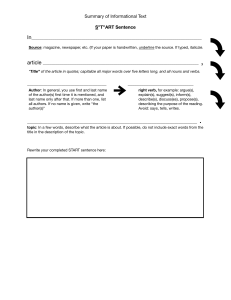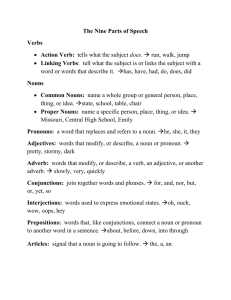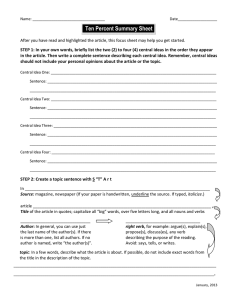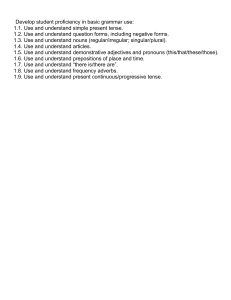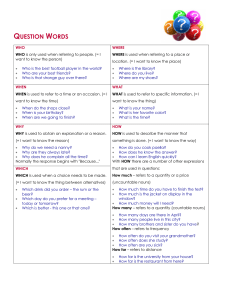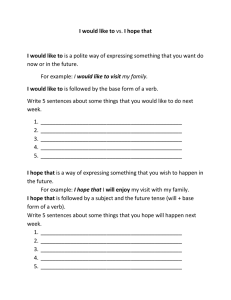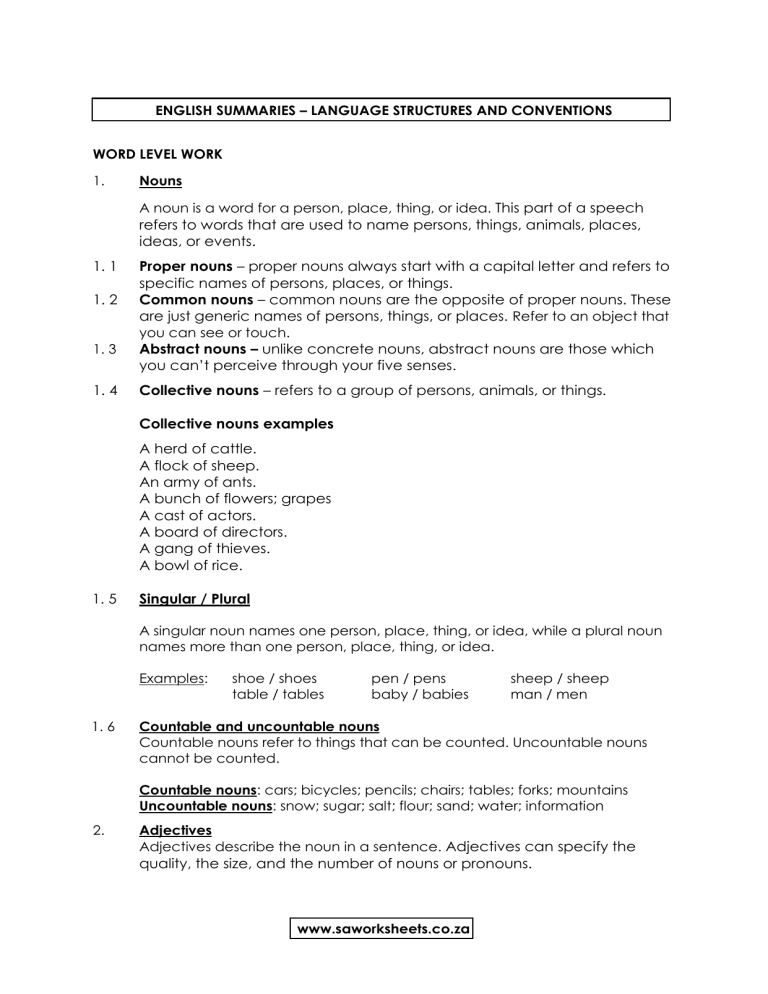
ENGLISH SUMMARIES – LANGUAGE STRUCTURES AND CONVENTIONS WORD LEVEL WORK 1. Nouns A noun is a word for a person, place, thing, or idea. This part of a speech refers to words that are used to name persons, things, animals, places, ideas, or events. 1. 1 1. 2 1. 3 1. 4 Proper nouns – proper nouns always start with a capital letter and refers to specific names of persons, places, or things. Common nouns – common nouns are the opposite of proper nouns. These are just generic names of persons, things, or places. Refer to an object that you can see or touch. Abstract nouns – unlike concrete nouns, abstract nouns are those which you can’t perceive through your five senses. Collective nouns – refers to a group of persons, animals, or things. Collective nouns examples A herd of cattle. A flock of sheep. An army of ants. A bunch of flowers; grapes A cast of actors. A board of directors. A gang of thieves. A bowl of rice. 1. 5 Singular / Plural A singular noun names one person, place, thing, or idea, while a plural noun names more than one person, place, thing, or idea. Examples: 1. 6 shoe / shoes table / tables pen / pens baby / babies sheep / sheep man / men Countable and uncountable nouns Countable nouns refer to things that can be counted. Uncountable nouns cannot be counted. Countable nouns: cars; bicycles; pencils; chairs; tables; forks; mountains Uncountable nouns: snow; sugar; salt; flour; sand; water; information 2. Adjectives Adjectives describe the noun in a sentence. Adjectives can specify the quality, the size, and the number of nouns or pronouns. www.saworksheets.co.za 2. 1 Degrees of comparison Most adjectives have three different forms to show degrees of comparison — the positive, the comparative, and the superlative. Examples: short fast shorter faster shortest fastest 3. Adverbs Adverbs are words that describe the verb in a sentence. 3. 1 Adverb of Manner– this refers to how something happens or how an action is done. She won the match convincingly. Adverb of Time - this states “when” something happens or “when” it is done. We went to the mall yesterday. Adverb of Place – this tells something about “where” something happens or ”where” something is done. She plays outside. Adverb of Degree – this states the intensity or the degree to which a specific thing happens or is done. I really love my parents. 3. 2 3. 3 3. 4 4. Pronouns A pronoun is a word used in place of a noun. A pronoun is a part of a speech which functions as a replacement for a noun. A pronoun is a word that can be used to replace a noun, and is usually used to avoid repetition of the noun. 4. 1 4. 2 4. 3 4. 4 4. 5 Personal pronouns refer to specific persons or things. She is special. Possessive pronouns show that something belongs to someone. It is mine. Demonstrative pronouns point out specific items. Those are my friends. Relative pronouns join sentences. My niece, who is from Ireland, is here. Reflexive pronouns normally end in “-self” or “-selves”, referring to the subject or noun in the sentence. She managed to inject herself. 5. Verbs Verbs express actions in sentences. It is commonly known as the doing word. this is a word that shows an action or state of being of the subject in a sentence. Auxiliary verbs help the main verb – also called the helping verb. Examples: I am sorry. She was walking. He is a great player. They are jogging. She will write the exam. Phrasal verbs are phrases that indicate actions. They are generally used in spoken English and informal texts. Phrasal verbs = verb + preposition or verb + adverb Examples: ask for; come across; take off; turn around; sit down www.saworksheets.co.za Finite verbs Finite verbs have a tense and a subject. There must be agreement between the subject and the verb. Craig loves playing cricket. Craig loved playing cricket. Infinite verbs Infinite verbs do not change when the subject changes. The auxiliary verb changes. Craig has visited his parents regularly. They have visited their parents regularly. Regular verbs In the past tense, we normally add “ed” to the verb. The spelling of the verb is consistent. Examples: help / helped laugh / laughed Irregular verbs In the past tense, the spelling of the verb is inconsistent with the present tense. Examples: write / wrote 6. Prepositions A preposition is a word placed before a noun or pronoun to form a phrase modifying another word in the sentence. This part of a speech basically refers to words that specify location or a location in time. Examples: 7. 9. The girl passed her test. She prepared well. The girl passed her test, because she prepared well. Interjections An interjection is a word used to express emotion. It is often followed by an exclamation point. Synonyms A synonym is a word having the same or nearly the same meaning as another word or a phrase. Examples: 10. with; at; from; onto; into; during; to; of; against between; next to; behind; among; over; under beyond; near; around; above; out; towards Conjunctions A conjunction joins words, phrases, or clauses, and indicates the relationship between the elements joined. The conjunction is a part of a speech which joins words, phrases, or clauses together. Example: 8. feel / felt smart / clever essential / important exact / specific Antonyms Antonyms are words which have the opposite meaning. Examples: new / old begin / end www.saworksheets.co.za false / true 11. Homonyms Homonyms are two words that are spelt the same and sound the same but have different meanings. Examples: right Turn right at the traffic light. I have a right to be educated. You were wrong and she was right. 12. Homophones Homophones are words that sound the same, but are spelt differently and have different meanings. Examples: blue / blew flower / flour key / quay The sky is blue. The referee blew the whistle. That is a colourful flower. Mom uses flour when she bakes bread. 13. Roots; stems / prefixes and suffixes The root or stem is the most basic form and meaning of a word. Its meaning can be changed when prefixes or suffixes are added to it. Examples: togetherness Root / stem: together Suffix: ness uncalled Prefix: un Root . stem: call Suffix: ed 14. Determiners A determiner is a modifier of a noun that provides more information about the noun, such as how much or by whom. Demonstrative determiners: those Possessive determiners: mine Definite article: the Indefinite articles: a; an Quantifiers: some, any 15. (Those children are in my class) (That bicycle is mine) (The boy took my pencil) (A boy took my pencil) (I want some coffee) Metonomy When a word is used as a substitute for another word to which it is closely related. New set of wheels – car, motorbike, etc New blood – new people Several officers – police www.saworksheets.co.za B. SENTENCE LEVEL WORK 1. Simple sentences A Simple Sentence is a sentence with just one indepent clause, and no dependent or subordinate clauses. 1. 1 Types of simples sentences a) Compound Verbs and Compound Subjects – Some sentences have a single subject and two or more verbs. Other sentences have a single verb and two or more subjects. b) Single Subject and a Single Verb – This type of simple sentence has only one subject and one verb. We can identify the subject, verb and object in simple sentences. Example: The man is eating his food. Subject: Verb: Object: 2. The man (is) eating (his) food Complex sentences A complex sentence is a sentence with an independent clause and a dependent clause. It is one of the four main types of sentence structures. In a complex sentence, the independent clause shares the main information, and the dependent clause(s) provide details. Example: He saw the car that was used during the robbery. 3. Active and passive voice In the active voice, a subject does an action to an object. Example: The thief stole my wallet. The passive voice is used when we want to emphasize the action (the verb) and the object of a sentence rather than subject. Example: 4. My wallet was stolen by the thief. Subject – verb agreement Subjects in a sentences that are plural or singular, must have an agreeing verb. Therefore, if a subject is singular, the verb must also be singular. If the subject is plural, the verb must also be plural. Examples: Singular – She is hungry. Plural – They are hungry. Singular – Peter walks to school. Plural – Peter and his friends walk to school. www.saworksheets.co.za 5. Direct and indirect speech Direct speech is a quotation of a person’s exact words – and those words are written between inverted commas. Indirect speech is a report of what someone has said. Example: 6. Idioms Idioms are word combinations that have a different figurative meaning than the literal meanings of each word or phrase. Examples: 7. Direct speech – Mary told her mom, “I passed my test.” Indirect speech – Mary told her mom that she passed her test. Burning the midnight oil Burn your bridges Every cloud has a silver lining It takes two to tango Water under the bridge Beat around the bush Pay an arm and a leg Kill two birds with one stone A stitch in time saves nine Let sleeping dogs lie Let the cat out of the bag See eye to eye Break a leg Get off my tail On cloud nine Sit on the fence Tenses The past tense tells us about things that have happened. She baked a cake. The present tense tells us about things that are happening. She bakes a cake. The future tense tells us about things that will happen. She will bake a cake. Progressive tenses The progressive tenses indicate continuing actions. The main verb changes, because “ing” is added to it. An auxiliary verb (is, was, were, etc) are used with the main verb. The past progressive tense tells us about things that were happening. She was baking a cake. They were practising. The present progressive tense tells us about things that are happening. She is baking a cake. They are practising. www.saworksheets.co.za The future progressive tense tells us about things that will be happening. She will be baking a cake. They will be practising. C. D. PUNCTUATION 1. Full stop - 2. Comma - 3. Question mark - 4. Exclamation mark - 5. Semicolon - 6. Colon - 7. Hyphen - 8. Apostrophe - 9. Quotation marks - 10. Capital letter - used at the end of a sentence used in certain abbreviations used after words in a list for breathing space in long sentences indicates a direct question when placed at the end of a sentence is used when a person wants to express a sudden outcry or add emphasis. is used to connect independent clauses. It shows a closer relationship between the clauses than a period would show. is used after a word introducing a quotation, an explanation, an example, or a series. between independent clauses, when the second explains the first is used to join two or more words together into a compound term. is used to indicate the omission of a letter or letters from a word, the possessive case, or the plurals of lowercase letters. double quotation marks are used to directly and exactly quote the words of someone. used at the beginning of a sentence for all proper nouns POETRY 1. Simile - A comparison between two different things introduced by “like” or “as”. He is just like his father. She is as helpful as her mom. 2. Metaphor - It implies a comparison between two things. Unlike the simile, “like” or “as” is not used. He is the star of the class. That man is a tower of strength. 3. Personification - When human characteristics are attributed to non – human and often lifeless things. The clouds embraced the sun. The birds chattered all morning. www.saworksheets.co.za 4. Alliteration - A poetic technique in which the initial consonant sounds of words are repeated in close succession. The barbarians broke through the barricade. 5. Assonance - The rhyming of vowels within two or more words close together to create effect. A stitch in time saves nine. 6. Repetition - When a word is repeated for rhyme or emphasis. She wore a red dress with red ribbons and red shoes. 7. Rhyme - A rhyme is a repetition of similar sounding words, occurring at the end of lines in poems or songs. The dog likes to bark Especially when it’s dark 8. Rhythm - The rhythm of a poem gives it its flow and beat. 9. Stanza - A set of lines in a poem grouped together and set apart from other stanzas in the poem. 10. Line - A string of words before a break. Lines make up a stanza. www.saworksheets.co.za
